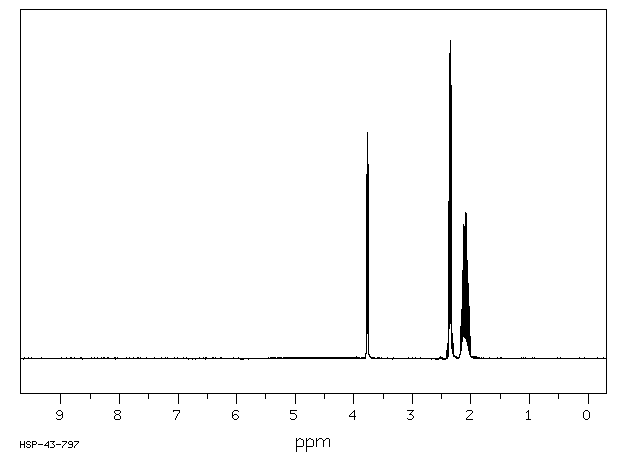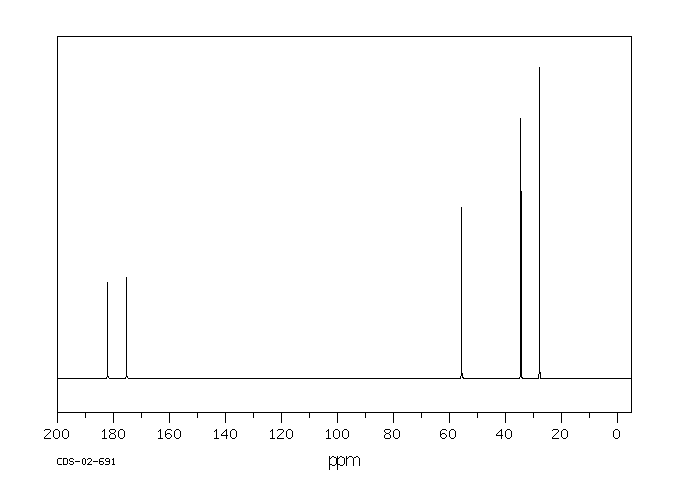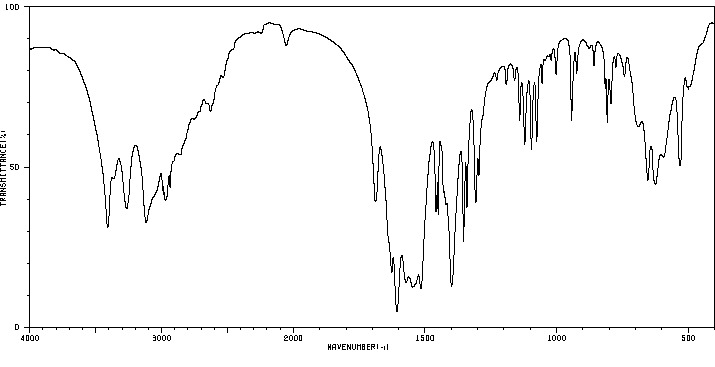monosodium L-glutamate | 142-47-2
物质功能分类
-
物化性质
-
计算性质
-
ADMET
-
安全信息
-
SDS
-
制备方法与用途
-
上下游信息
-
文献信息
-
表征谱图
-
同类化合物
-
相关功能分类
-
相关结构分类
物化性质
-
熔点:232°C
-
比旋光度:20 -3.5° (10% soln in 5° Bé HCl); D20 +25.16° (10g MSG/100ml 2N HCl)
-
密度:d20 (saturated water soln): 1.620
-
溶解度:易溶于水;微溶于乙醇(95%)。
-
LogP:-1.44
-
物理描述:Monosodium glutamate appears as white or off-white crystalline powder with a slight peptone-like odor. pH (0.2% solution)7.0. (NTP, 1992)
-
颜色/状态:White free flowing crystals or crystalline powder
-
气味:Practically odorless
-
味道:Meaty taste comes from contaminants in crude glutamates; sweet-saline taste in large concn; no flavor in small quantity
-
沸点:225 °C (decomposes)
-
旋光度:Specific optical rotation: +24.2 to +25.5 deg at 25 °C/D (concn = 8.0 g in 100 mL 1.0 N hydrochloric acid)
-
分解:When heated to decomposition it emits toxic fumes of oxides of /nitrogen and sodium oxide/.
-
稳定性/保质期:
- 常温常压下稳定,禁配强氧化剂。
计算性质
-
辛醇/水分配系数(LogP):-5.07
-
重原子数:11
-
可旋转键数:4
-
环数:0.0
-
sp3杂化的碳原子比例:0.6
-
拓扑面积:103
-
氢给体数:2
-
氢受体数:5
ADMET
安全信息
-
TSCA:Yes
-
危险类别码:R20/21/22
-
WGK Germany:2
-
海关编码:2922422000
-
RTECS号:MA1578000
-
危险性防范说明:P261,P280,P305+P351+P338
-
危险性描述:H302,H312,H319,H332,H335
-
储存条件:1. 存放时请密封于干燥阴凉处。 2. 不可与强酸、氧化剂或易燃品共同储存和运输。
SDS
模块 1. 化学品
1.1 产品标识符
: L-Glutamic acid 单钠盐 水合物
产品名称
1.2 鉴别的其他方法
无数据资料
1.3 有关的确定了的物质或混合物的用途和建议不适合的用途
仅用于研发。不作为药品、家庭或其它用途。
模块 2. 危险性概述
2.1 GHS-分类
非危险物质或混合物。
2.3 其它危害物 - 无
模块 3. 成分/组成信息
3.1 物 质
: C5H8NNaO4 · xH2O
分子式
: 169.11 g/mol
分子量
无
模块 4. 急救措施
4.1 必要的急救措施描述
吸入
如果吸入,请将患者移到新鲜空气处。 如呼吸停止,进行人工呼吸。
皮肤接触
用肥皂和大量的水冲洗。
眼睛接触
用水冲洗眼睛作为预防措施。
食入
切勿给失去知觉者通过口喂任何东西。 用水漱口。
4.2 主要症状和影响,急性和迟发效应
据我们所知,此化学,物理和毒性性质尚未经完整的研究。
4.3 及时的医疗处理和所需的特殊处理的说明和指示
无数据资料
模块 5. 消防措施
5.1 灭火介质
灭火方法及灭火剂
用水雾,抗乙醇泡沫,干粉或二氧化碳灭火。
5.2 源于此物质或混合物的特别的危害
碳氧化物, 氮氧化物, 氧化钠
5.3 给消防员的建议
如必要的话,戴自给式呼吸器去救火。
5.4 进一步信息
无数据资料
模块 6. 泄露应急处理
6.1 作业人员防护措施、防护装备和应急处置程序
避免粉尘生成。 避免吸入蒸气、烟雾或气体。
6.2 环境保护措施
不要让产品进入下水道。
6.3 泄漏化学品的收容、清除方法及所使用的处置材料
扫掉和铲掉。 放入合适的封闭的容器中待处理。
6.4 参考其他部分
丢弃处理请参阅第13节。
模块 7. 操作处置与储存
7.1 安全操作的注意事项
在有粉尘生成的地方,提供合适的排风设备。
7.2 安全储存的条件,包括任何不兼容性
贮存在阴凉处。 使容器保持密闭,储存在干燥通风处。
建议的贮存温度: 15 - 25 °C
7.3 特定用途
无数据资料
模块 8. 接触控制和个体防护
8.1 容许浓度
最高容许浓度
没有已知的国家规定的暴露极限。
8.2 暴露控制
适当的技术控制
常规的工业卫生操作。
个体防护设备
眼/面保护
请使用经官方标准如NIOSH (美国) 或 EN 166(欧盟) 检测与批准的设备防护眼部。
皮肤保护
戴手套取 手套在使用前必须受检查。
请使用合适的方法脱除手套(不要接触手套外部表面),避免任何皮肤部位接触此产品.
使用后请将被污染过的手套根据相关法律法规和有效的实验室规章程序谨慎处理. 请清洗并吹干双手
所选择的保护手套必须符合EU的89/686/EEC规定和从它衍生出来的EN 376标准。
身体保护
根据危险物质的类型,浓度和量,以及特定的工作场所选择身体保护措施。,
防护设备的类型必须根据特定工作场所中的危险物的浓度和数量来选择。
呼吸系统防护
不需要保护呼吸。如需防护粉尘损害,请使用N95型(US)或P1型(EN 143)防尘面具。
呼吸器使用经过测试并通过政府标准如NIOSH(US)或CEN(EU)的呼吸器和零件。
模块 9. 理化特性
9.1 基本的理化特性的信息
a) 外观与性状
形状: 固体
颜色: 白色
b) 气味
无数据资料
c) 气味阈值
无数据资料
d) pH值
无数据资料
e) 熔点/凝固点
熔点/凝固点: 232 °C
f) 沸点、初沸点和沸程
无数据资料
g) 闪点
无数据资料
h) 蒸发速率
无数据资料
i) 易燃性(固体,气体)
无数据资料
j) 高的/低的燃烧性或爆炸性限度 无数据资料
k) 蒸气压
无数据资料
l) 蒸汽密度
无数据资料
m) 密度/相对密度
1.65 g/cm3 在 20 °C
n) 水溶性
417 g/l 在 20 °C - 可溶的
o) n-辛醇/水分配系数
辛醇--水的分配系数的对数值: < -4 在 20 °C
p) 自燃温度
无数据资料
q) 分解温度
无数据资料
r) 粘度
无数据资料
模块 10. 稳定性和反应活性
10.1 反应性
无数据资料
10.2 稳定性
无数据资料
10.3 危险反应
无数据资料
10.4 应避免的条件
无数据资料
10.5 不相容的物质
强氧化剂
10.6 危险的分解产物
其它分解产物 - 无数据资料
模块 11. 毒理学资料
11.1 毒理学影响的信息
急性毒性
半数致死剂量 (LD50) 经口 - 大鼠 - 雄性 - 17.3 g/kg
半数致死剂量 (LD50) 经口 - 大鼠 - 雌性 - 15.8 g/kg
半数致死剂量 (LD50) 经皮 - 大鼠 - 雄性和雌性 - > 2,000 mg/kg
皮肤刺激或腐蚀
皮肤 - 兔子 - 无皮肤刺激 - 4 h - 指令67/548/EEC,附录V,B.4。
眼睛刺激或腐蚀
眼睛 - 兔子 - 无眼睛刺激 - 7 d - 指令67/548/EEC,附录V,B.5。
呼吸道或皮肤过敏
过敏原的最大化试验 - 豚鼠 - 不引起皮肤过敏。 - 指令67/548/EEC,附录V,B.6。
生殖细胞致突变性
细胞突变性-体外试验 - Ames 试验(艾姆斯试验) - 鼠伤寒沙门氏菌 - 有或没有代谢活化作用 - 阴性
细胞突变性-体内试验 - 小鼠 - 雄性 - 经口 - 阴性
致癌性
IARC:
此产品中没有大于或等于 0。1%含量的组分被 IARC鉴别为可能的或肯定的人类致癌物。
生殖毒性
无数据资料
特异性靶器官系统毒性(一次接触)
无数据资料
特异性靶器官系统毒性(反复接触)
无数据资料
吸入危险
无数据资料
潜在的健康影响
吸入 吸入可能有害。 可能引起呼吸道刺激。
摄入 如服入是有害的。
皮肤 通过皮肤吸收可能有害。 可能引起皮肤刺激。
眼睛 可能引起眼睛刺激。
接触后的征兆和症状
据我们所知,此化学,物理和毒性性质尚未经完整的研究。
附加说明
反复染毒毒性 - 犬 - 雄性和雌性 - 未观察到有害效果的水平 - >= 15,000 mg/kg
化学物质毒性作用登记: 无数据资料
模块 12. 生态学资料
12.1 生态毒性
对鱼类的毒性 静态试验 半数致死浓度(LC50) - 鲫属 (鲤鱼) - > 100 mg/l - 96 h
方法: 经济合作和发展组织的试验指导书203
对水蚤和其他水生无脊 静态试验 半数效应浓度(EC50) - 大型蚤 (水蚤) - > 100 mg/l - 48 h
椎动物的毒性 方法: 经济合作和发展组织的试验指导书202
对藻类的毒性 静态试验 半数效应浓度(EC50) - 近头状伪蹄形藻 (绿藻) - > 2 mg/l - 72 h
方法: 经济合作和发展组织的试验指导书201
12.2 持久性和降解性
生物降解能力 好氧的 - 接触时间 28 d
结果: 78 % - 快速生物降解
方法: 经合组织(OECD )测试指南 301B
12.3 潜在的生物累积性
无数据资料
12.4 土壤中的迁移性
无数据资料
12.5 PBT 和 vPvB的结果评价
无数据资料
12.6 其它不良影响
无数据资料
模块 13. 废弃处置
13.1 废物处理方法
产品
将剩余的和不可回收的溶液交给有许可证的公司处理。
受污染的容器和包装
按未用产品处置。
模块 14. 运输信息
14.1 联合国危险货物编号
欧洲陆运危规: - 国际海运危规: - 国际空运危规: -
14.2 联合国运输名称
欧洲陆运危规: 非危险货物
国际海运危规: 非危险货物
国际空运危规: 非危险货物
14.3 运输危险类别
欧洲陆运危规: - 国际海运危规: - 国际空运危规: -
14.4 包裹组
欧洲陆运危规: - 国际海运危规: - 国际空运危规: -
14.5 环境危险
欧洲陆运危规: 否 国际海运危规 国际空运危规: 否
海洋污染物(是/否): 否
14.6 对使用者的特别提醒
无数据资料
模块 16. 其他信息
进一步信息
版权所有:2013 Co. LLC. 公司。许可无限制纸张拷贝,仅限于内部使用。
上述信息视为正确,但不包含所有的信息,仅作为指引使用。本文件中的信息是基于我们目前所知,就正
确的安全提示来说适用于本品。该信息不代表对此产品性质的保证。
参见发票或包装条的反面。
模块 15 - 法规信息
N/A
制备方法与用途
以下是关于谷氨酸钠(味精)的一些重要信息:
用途- 医药:用作药物的中间体。
- 调味品:作为食品添加剂,增加食物风味。
- 工业应用:作为有机合成的中间体。
-
原料发酵法
- 主要以大米、淀粉或糖蜜为原料。
- 经过糖化、发酵、提取和精制等工序获得谷氨酸。
- 中和与精制
- 理论收率:92%~90%
- 成品相对密度1.28(31.5084)
- 1987年,第19届联合国粮农组织及世界卫生组织食品添加剂法规委员会会议取消了对食品用味精的限量规定。
反应信息
-
作为反应物:描述:参考文献:名称:METHOD FOR PRECIPITATING alpha-CRYSTALS OF GLUTAMIC ACID摘要:公开号:EP2163539B1
-
作为产物:描述:sodium α-ketoglutarate 在 ammonium hydroxide 、 paraquat dichloride 、 烟酰胺腺嘌呤双核苷酸磷酸盐 、 sodium sulfate 、 2-巯基乙醇 作用下, 反应 168.0h, 以84%的产率得到monosodium L-glutamate参考文献:名称:Enzyme-catalyzed organic synthesis: electrochemical regeneration of NAD(P)H from NAD(P) using methyl viologen and flavoenzymes摘要:DOI:10.1021/jo00335a078
-
作为试剂:描述:胸苷酸 在 乙酰磷酸 、 recombinant N-terminally hexahistidine-tagged Streptomyces ravidus RavAMT TDP-3-keto-6-deoxy-D-galactose-3-aminotransferase 、 recombinant N-terminally histidine-tagged acetate kinase 、 recombinant N-terminally histidine-tagged Escherichia coli RmlB TDP-D-glucose-4,6-dehydratase 、 recombinant N-terminally histidine-tagged RavIM TDP-4-keto-6-deoxy-D-glucose-3,4-ketoisomerase 、 recombinant N-terminally histidine-tagged Salmonella typhimurium RfbA TDP-D-glucose synthase 、 recombinant N-terminally histidine-tagged Streptomyces ravidus RavNMT TDP-3-amino-3,6-dideoxy-D-galactose-N,N-dimethyl-transferase 、 recombinant N-terminally histidine-tagged thymidine monophosphate kinase 、 磷酸吡哆醛 、 monosodium L-glutamate 、 5’-三磷酸腺苷 、 magnesium chloride 作用下, 以 水 为溶剂, 反应 2.5h, 生成 dTDP-D-ravidosamine 、 Dtdp-3-N-Methylamino-3,6-Dideoxygalactose参考文献:名称:TDP-d-拉多糖胺生物合成途径的表征:从胸苷-5-磷酸和葡萄糖-1-磷酸中一锅法酶促合成TDP-d-拉多糖胺†摘要:Ravidomycin V 和相关化合物,例如,FE35A-B在可见光存在下,对各种癌细胞系表现出有效的抗癌活性。氨基糖部分(D-萝卜糖胺与具有中性或支链糖的密切相关的化合物相比,这些分子中的拉维霉素和类似物的效力更高。在拉维霉素 V 生物合成基因簇中,五个假定的基因编码NDP- D-拉维多胺鉴定了生物合成酶。通过分离的酶的活性在体外,据证实ravD,RAVE,ravIM,ravAMT和ravNMT编码TDP- D-葡萄糖合酶,TDP-4-酮-6-脱氧d -葡萄糖-4,6-脱水酶,TDP-4-酮-6-脱氧d -葡萄糖-3,4-酮异构酶,TDP-3-酮-6-脱氧-D-半乳糖-3-氨基转移酶和TDP-3-氨基-3,6-双脱氧-D-半乳糖-N、N-二甲基-转移酶。一锅酶法合成的方案TDP- d -ravidosamine已经被开发出来。此处提供的结果现在为产生TDP- d -ravidosamineDOI:10.1039/c0ob00854k
文献信息
-
Bio-based N-alkyl-2-pyrrolidones by Pd-catalyzed reductive N-alkylation and decarboxylation of glutamic acid作者:Free De Schouwer、Sander Adriaansen、Laurens Claes、Dirk E. De VosDOI:10.1039/c7gc01829k日期:——controversial high-boiling solvents such as N-methyl-2-pyrrolidone and N,N-dimethylformamide in the chemical industry. Recently, N-alkyl-2-pyrrolidones and 5-methyl-N-alkyl-2-pyrrolidones were proposed as attractive alternative solvents for many applications. Here, we report a bio-based two-step chemocatalytic system for the synthesis of a broad range of N-alkyl-2-pyrrolidones starting from glutamic acid环保法规推动新的更安全,毒性较低的生物基溶剂的查找替换争议的高沸点溶剂,如ñ甲基-2-吡咯烷酮和ñ,ñ在化工行业二甲基甲酰胺。最近,N-烷基-2-吡咯烷酮和5-甲基-N-烷基-2-吡咯烷酮被提议作为许多应用的有吸引力的替代溶剂。在这里,我们报告了一种基于生物的两步化学催化系统,该系统可以从谷氨酸和C 3 -C 5羰基化合物开始合成范围广泛的N-烷基-2-吡咯烷酮。第一步N通过温和且有效的Pd催化的还原性N-烷基化以高产率(> 85%)合成了谷氨酸的α-单烷基化衍生物。随后,在惰性气氛下在250℃下热诱导内酰胺化成相应的N-烷基焦谷氨酸,然后Pd催化脱羧,得到N-烷基-2-吡咯烷酮。通过用碱中和N-烷基焦谷氨酸底物,部分抵消了水解降解,导致产率高达82%。最后,两个反应步骤在相同的Pd / Al 2 O 3催化剂下,在不同的气体气氛和温度条件下,通过一锅法成功地结合在一起。
-
Decarboxylation of a Wide Range of Amino Acids with Electrogenerated Hypobromite作者:Roman Matthessen、Laurens Claes、Jan Fransaer、Koen Binnemans、Dirk E. De VosDOI:10.1002/ejoc.201403112日期:2014.10Bromide-assisted electrochemical decarboxylation efficiently produces valuable nitriles in high yields from a wide range of naturally occurring amino acids in a single step. Bromide salts are used as both redox mediators and supporting electrolytes in a simple one-compartment setup. As demonstrated for lysine, the selectivity of the decarboxylation can be tuned towards nitriles, amines or amides.
-
Bio-Based Nitriles from the Heterogeneously Catalyzed Oxidative Decarboxylation of Amino Acids作者:Laurens Claes、Roman Matthessen、Ine Rombouts、Ivo Stassen、Trees De Baerdemaeker、Diederik Depla、Jan A. Delcour、Bert Lagrain、Dirk E. De VosDOI:10.1002/cssc.201402801日期:2015.1The oxidative decarboxylation of amino acids to nitriles was achieved in aqueous solution by in situ halide oxidation using catalytic amounts of tungstate exchanged on a [Ni,Al] layered double hydroxide (LDH), NH4Br, and H2O2 as the terminal oxidant. Both halide oxidation and oxidative decarboxylation were facilitated by proximity effects between the reactants and the LDH catalyst. A wide range of
-
一种利用管式反应器连续合成谷氨酸二乙酸 四钠的方法
-
Host Marking Pheromone (HMP) in the Mexican Fruit Fly Anastrepha ludens作者:Andrew J. F. Edmunds、Martin Aluja、Fransico Diaz-Fleischer、Bruno Patrian、Leonhard HagmannDOI:10.2533/chimia.2010.37日期:——
Host marking pheromones (HMPs) are used by insects to mark hosts (usually a fruit) where they have already laid eggs. The compounds serve as a deterrent to conspecifics avoiding over-infestation of hosts (i.e. repeated egg-laying into an already occupied/used host). If these HMPs are sprayed onto commercially valuable fruit they act as deterrents preventing attack by females interested in laying eggs into the valuable commodity. Having no insecticidal or toxic properties, and being natural products (or close derivatives thereof) they could be used as fruit sprays to replace insecticides, or in combination with other products to improve efficacy. This review discusses the isolation, and synthesis of the HMP of the Mexican fruit fly Anastrepha ludens a feared pest of citrus and mangos in Mexico and Central America. This compound is also recognized by females of other pestiferous species in the same genus Anastrepha distributed from the Southern USA to Northern Argentina, including many Caribbean Islands. The synthetic HMP was shown to exhibit strong electrophysiological activity against A. ludens and excellent interspecies cross recognition with other Anastrepha species. Behavioural tests confirmed the HMP deterring effect of the synthetic natural product. Further studies enabled us to drastically simplify the structure of the HMP and obtain a derivative, which we named Anastrephamide, which shows HMP deterring effects very similar to the natural product in laboratory and field tests. The potential use of such HMP derivatives in a crop protection scenario is briefly discussed.
寄主标记信息素(HMPs)被昆虫用来标记寄主(通常是水果),表明它们已经在那里产卵。这些化合物作为一种抑制剂,避免同类过度寄生寄主(即重复在已被占用/使用的寄主中产卵)。如果将这些HMP喷洒到商业有价值的水果上,它们将起到抑制作用,防止雌性昆虫对有价值的商品产卵攻击。由于没有杀虫或毒性,且为天然产品(或其近似衍生物),它们可以用作水果喷雾剂,以取代杀虫剂,或与其他产品结合以提高效果。这篇评论讨论了墨西哥果蝇Anastrepha ludens的HMP的分离和合成,这是墨西哥和中美洲柑橘和芒果的可怕害虫。这种化合物也被同属Anastrepha的其他害虫物种的雌性识别,这些物种分布在从美国南部到阿根廷北部,包括许多加勒比岛屿。合成的HMP表现出对A. ludens的强电生理活性,与其他Anastrepha物种具有出色的种间交叉识别能力。行为测试证实了合成天然产品的HMP抑制效果。进一步的研究使我们大大简化了HMP的结构,并获得了一个衍生物,我们将其命名为Anastrephamide,它在实验室和田间试验中显示出与天然产品非常相似的HMP抑制效果。这种HMP衍生物在作物保护方案中的潜在用途被简要讨论。
表征谱图
-
氢谱1HNMR
-
质谱MS
-
碳谱13CNMR
-
红外IR
-
拉曼Raman
-
峰位数据
-
峰位匹配
-
表征信息









